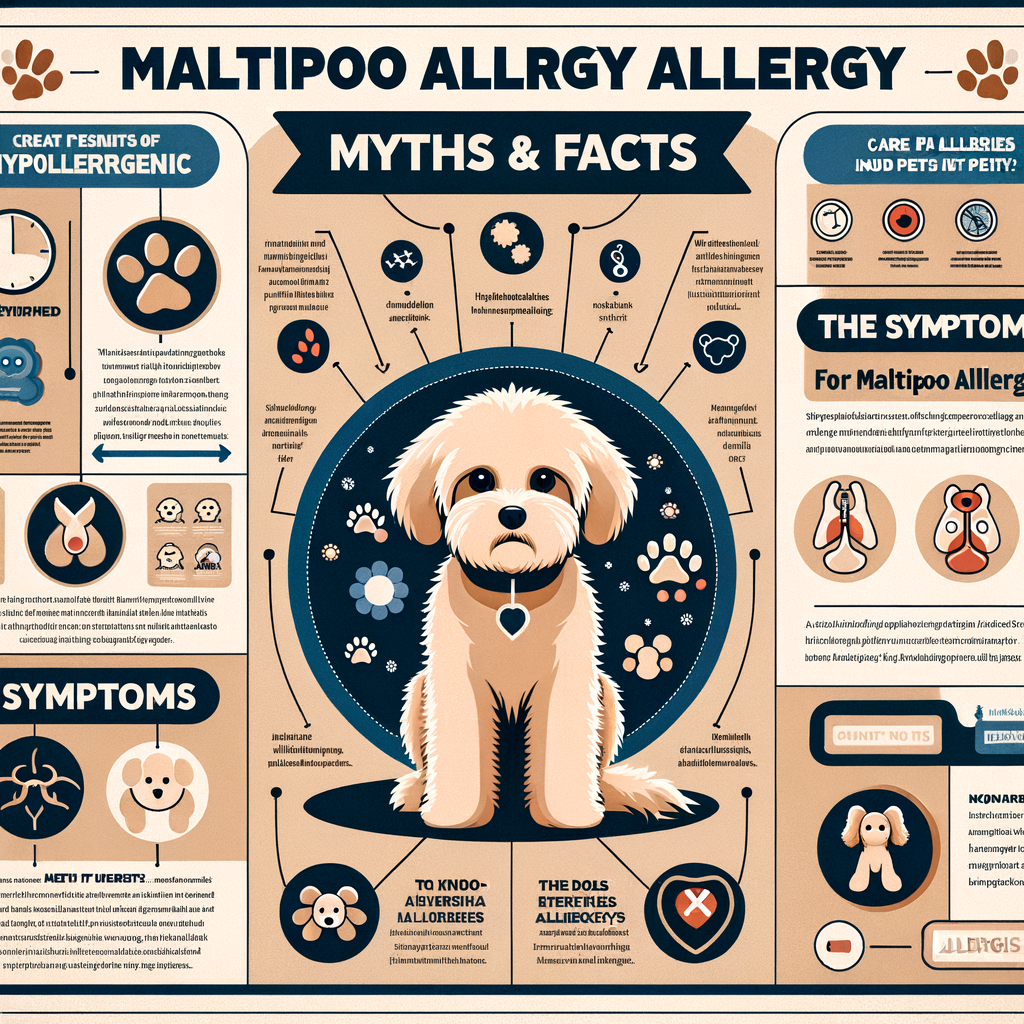
Introduction: Understanding Maltipoo Allergies
When it comes to our furry friends, their health is our top priority. One common concern among Maltipoo owners is allergies. In this article, we will delve into the world of Maltipoo allergies, dispelling common myths and providing you with the knowledge you need to keep your pet healthy and happy.
- Defining Maltipoo Allergies
- Common Misconceptions About Maltipoo Allergies
Allergies in Maltipoos, like in humans, are the body’s overreaction to certain substances, known as allergens. These allergens can be anything from food to dust mites, and they can cause a variety of symptoms in your Maltipoo, including itching, sneezing, and digestive issues. It’s important to remember that each Maltipoo is unique, and what causes an allergic reaction in one may not affect another.
There are many misconceptions about Maltipoo allergies. One common myth is that Maltipoos are hypoallergenic and therefore cannot have allergies. This is not true. While Maltipoos are less likely to cause allergies in humans due to their low-shedding coats, they can still suffer from allergies themselves. Another misconception is that allergies are not serious and can be ignored. In reality, untreated allergies can lead to more serious health problems for your Maltipoo, like skin infections or respiratory issues.
Understanding Maltipoo allergies is the first step to ensuring your pet’s well-being. In the following sections, we will debunk more myths, provide factual information, help you recognize allergy symptoms, and offer tips for caring for a Maltipoo with allergies.
Maltipoo Allergy Myths Debunked
When it comes to Maltipoo allergies, there are many myths that people believe. One of the most common is that Maltipoos are hypoallergenic. Let’s debunk this myth and provide you with the facts.
Myth 1: Maltipoos are Hypoallergenic
The term ‘hypoallergenic’ is often used to describe breeds like the Maltipoo. But what does this term really mean? And is it accurate to say that Maltipoos are hypoallergenic?
- Understanding the term “hypoallergenic”
- Why no breed is truly hypoallergenic
The term ‘hypoallergenic’ means ‘below normal’ or ‘slightly’ allergenic. So, when a dog is described as hypoallergenic, it means they are less likely to cause an allergic reaction compared to other breeds. However, this does not mean they won’t cause an allergic reaction at all.
While some breeds are labeled as hypoallergenic, no breed is truly hypoallergenic. This is because all dogs produce allergens, which are proteins found in a dog’s dander (dead skin), saliva, and urine. These allergens can cause reactions in people who are allergic to dogs. The amount of allergens a dog produces can vary greatly from one dog to another, even within the same breed. Therefore, it’s possible for a person to be allergic to one Maltipoo but not another.
In conclusion, while Maltipoos are often described as hypoallergenic, this does not mean they won’t cause an allergic reaction. It’s always important to spend time with a dog before bringing them into your home, especially if you or a family member has allergies.
Myth 2: All Maltipoos Cause Allergies
It’s a common misconception that all Maltipoos cause allergies. However, this is not entirely accurate. The truth is, how a person reacts to a Maltipoo, or any dog breed for that matter, largely depends on their individual sensitivity to allergens.
- How individual reactions to allergens vary
- Case study: Different reactions to the same Maltipoo
People’s immune systems react differently to various allergens. Some people might experience severe allergic reactions, while others might not show any symptoms at all. This variation is due to the fact that our immune systems are unique and respond to allergens in different ways. Just as some people are allergic to peanuts while others can eat them without any problems, the same goes for exposure to pets like Maltipoos.
Let’s consider a real-life example. Suppose a family of four adopts a Maltipoo. The parents and the older child have no allergic reactions to the dog. However, the youngest child starts to show symptoms like sneezing, itching, and watery eyes. This scenario clearly illustrates how different individuals can have different reactions to the same Maltipoo.
In conclusion, it’s important to remember that not all Maltipoos cause allergies. Whether or not a person will have an allergic reaction to a Maltipoo depends largely on their individual immune system’s response to the dog’s allergens. Therefore, it’s always a good idea to spend some time with a Maltipoo before deciding to bring one into your home, especially if you or a family member has a history of allergies.
Maltipoo Allergy Facts
When it comes to Maltipoos, there are several important facts about allergies that you should be aware of. These facts can help you understand why some people may experience allergic reactions to these adorable dogs and how to manage these reactions.
- Fact 1: Maltipoos can cause allergies in some people
- Fact 2: Allergy symptoms can be managed
- Fact 3: Regular grooming can reduce allergens
Despite their hypoallergenic reputation, Maltipoos can indeed cause allergies in some people. This is because they produce dander, a common allergen, just like any other dog. Dander is tiny particles of skin that animals shed, and it can cause allergic reactions in sensitive individuals. According to a study by the American College of Allergy, Asthma, and Immunology, about 10% of the U.S. population is allergic to dogs.
While it’s true that Maltipoos can cause allergies, it’s also true that these allergies can be managed. There are many over-the-counter and prescription medications available that can help control allergy symptoms. In addition, simple steps like washing hands after petting a dog, not allowing the dog in the bedroom, and using air purifiers can also help reduce allergens in the home.
Regular grooming is another effective way to reduce allergens. By bathing your Maltipoo regularly and keeping their fur trimmed, you can significantly reduce the amount of dander they produce. According to the American Kennel Club, a regular grooming routine not only keeps your dog looking its best but also helps to remove dead skin and loose hairs that can contribute to allergies.
In conclusion, while Maltipoos can cause allergies in some people, there are many ways to manage these symptoms and reduce allergens. By understanding these facts, you can make an informed decision about whether a Maltipoo is the right pet for you.
Recognizing Maltipoo Allergy Symptoms
As a Maltipoo owner, it’s crucial to understand and recognize the signs of allergies in your pet. Allergies can cause discomfort and distress, and early detection can help manage the symptoms effectively. Let’s explore the common symptoms of Maltipoo allergies and how to differentiate them from other conditions.
- Common symptoms of Maltipoo allergies
- Excessive scratching: If your Maltipoo is scratching more than usual, it could be due to an allergic reaction.
- Red, inflamed skin: Allergies often cause skin irritation, leading to redness and inflammation.
- Runny nose and watery eyes: These are common symptoms of respiratory allergies in Maltipoos.
- Chronic ear infections: If your Maltipoo is frequently suffering from ear infections, it could be a sign of an underlying allergy.
- How to differentiate between Maltipoo allergies and other conditions
- Duration and frequency: Allergy symptoms tend to persist for a longer time and occur more frequently than symptoms of other conditions.
- Response to treatment: If your Maltipoo’s symptoms improve with allergy medication but not with treatments for other conditions, it’s likely an allergy.
- Seasonal patterns: Allergies often have a seasonal pattern, with symptoms worsening during certain times of the year.
Maltipoos, like other breeds, can exhibit a range of symptoms if they’re suffering from allergies. Here are some of the most common signs:
Remember, these symptoms can also be caused by other health issues. Therefore, it’s essential to consult with a vet if you notice any of these signs.
While the symptoms of allergies can be similar to other conditions, there are a few key differences to keep in mind:
Understanding these differences can help you identify whether your Maltipoo is suffering from allergies or another health issue. However, always consult a vet for a proper diagnosis.
Maltipoo Allergy Care
When it comes to caring for your Maltipoo’s allergies, prevention is the best course of action. Here are some preventive measures you can take to help your furry friend stay healthy and happy.
Preventive Measures
- Regular grooming
Regular grooming is essential for Maltipoos. It helps to remove allergens that may be trapped in their fur. Brushing your Maltipoo’s coat daily can help to reduce the amount of allergens they are exposed to. - Using hypoallergenic pet products
Hypoallergenic pet products are designed to be less likely to cause an allergic reaction. This includes everything from food to shampoos and toys. Always check the labels before buying any product for your pet. - Over-the-counter medications
Over-the-counter medications can help to manage your Maltipoo’s allergy symptoms. However, it’s important to consult with your vet before giving your pet any new medication. - Prescription treatments
In some cases, your vet may prescribe specific treatments for your Maltipoo’s allergies. These treatments can help to reduce symptoms and improve your pet’s quality of life. - Allergy shots
Allergy shots, also known as immunotherapy, can help to reduce your Maltipoo’s sensitivity to allergens. These shots are typically given over a period of time and can help to reduce the severity of your pet’s allergic reactions. - Key takeaways about Maltipoo allergies
Maltipoo allergies can be managed with the right care and attention. Regular grooming, using hypoallergenic products, and consulting with your vet about medications and treatments can all help to keep your pet healthy. - Debunking Maltipoo myths: A recap
Remember, not all Maltipoos will develop allergies, and those that do can still lead happy, healthy lives with the right care. Don’t let myths and misconceptions about Maltipoo allergies stop you from providing the best care for your pet.








